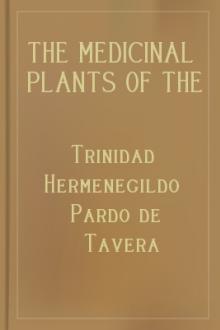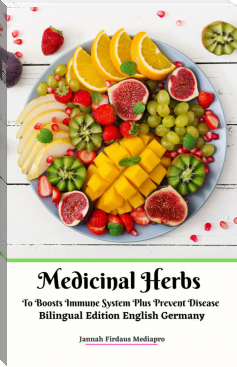The Medicinal Plants of the Philippines by Trinidad Hermenegildo Pardo de Tavera (best pdf ebook reader for android TXT) 📖

- Author: Trinidad Hermenegildo Pardo de Tavera
- Performer: -
Book online «The Medicinal Plants of the Philippines by Trinidad Hermenegildo Pardo de Tavera (best pdf ebook reader for android TXT) 📖». Author Trinidad Hermenegildo Pardo de Tavera
The chemical analysis of the seed is as follows:
Caffeine, the only one of the ingredients that interests us, was discovered by Hunge in 1821 and recognized as an alkaloid by Herzog. It also exists in tea, formerly known as “theine” which is now known to be identical with caffeine; both are expressed by the formula C8H10N2O2+H2O. It crystallizes in fine, silky needles, is colorless, odorless and slightly bitter.
It is considered a substitute for digitalis, especially valuable as a diuretic and where cerebral anemia exists. Germain See values it as a preventive medicine, acting principally upon the heart and thus preventing fatigue; with this end in view he advises its use before long marches, violent exercise and all conditions where the heart will be called upon to do a greatly increased amount of work. Dose 0.25 gram to 1 or 2 grams a day given by stomach or hypodermic injection.
Caffeine is also useful in headache, neuralgia, and asthma and as a general tonic. For the latter action it is best given in pill form, 0.02–0.04 gram a day, with the extract of cinchona or other bitter tonic.
“Etoxy-caffeine,” which is caffeine in which an atom of H has been replaced by the C2H5O, exists as white, needle-like crystals, slightly soluble in water; it is narcotic and sedative to the cerebro-spinal system. In doses of 0.24 gram it is useful in headache.
Botanical Description.—“A small tree that reaches a height of 8–9°. It grows readily in the province of Batangas without cultivation,” Blanco.
A small tree or shrub with leaves opposite, smooth, glossy, rich green, oval, edges fluted. Flowers fragrant, white, growing in small clusters in the axils of the leaves. Calyx 4–5-toothed. Corolla short-tubed with 4–5 spreading lobes of about the same length. Berry red, containing two plano-convex seeds enveloped in arils.
The plant is widely cultivated in gardens. It finds ideal conditions for growth in some of the hilly and mountainous regions of Luzon, notably in Benguet and Batangas.
Morinda citrifolia, L.; variety: bracteata, Hoock, Jr. (M. ligulata, Blanco.)
Nom. Vulg.—Bankundo, Pankundo, Bag̃kuro, Nino, Kulit, Tumbog̃aso, Lino, Mambog, Takpus, Tag. and Vis.; Taliantar, Pam.; Apalot, Iloc.; Indian Mulberry, Indo-Eng.
Uses.—In the Philippines, as well as in India, the root of the plant is widely used as a red dye. As a medicine the Tamul physicians use it in decoction to treat diarrhœa and dysentery. The fruit is emmenagogue and perhaps aperient. In Bombay the mashed leaves are applied to wounds and ulcers to hasten cicatrization; they also use the decoction internally as a febrifuge and tonic, 10 grams to 500 of water, a wineglassful twice a day.
The root bark contains a crystalline substance called by Anderson morindin, C28H30O15. It is a glucoside and exists in the form of yellow needles, soluble in alcohol and in cold water, insoluble in ether; dissolves in alkalies producing an orange-red color.
There is another species, M. tinctoria, Roxb.; M. Royoc, Blanco, called in Tagalog Tumboug̃ aso kapay, the roots of which are used by the Filipinos for the same purposes as the leaves of the former species; the dose, 8 grams a day. The powder is also applied to ulcers and sores, especially those of gangrenous aspect.
Botanical Description.—A small tree 11 or more feet high, branches opposite, quadrate at the extremities. Leaves opposite, oval, oblong, smooth, entire, glabrous. Petioles very short, with 2 broad, lanceolate stipules curved outward. Flowers white, opposite the leaves, fixed on globose, solitary receptacles from which spring the flowerets. Calyx proper, very short, monophyllous, a lanceolate leaflet springing from the border. Corolla tubular, woolly inside about the middle, with 5 lobules. Stamens 5, inserted on the walls of the corolla. Anthers thin, incumbent. Pistil somewhat longer than the corolla. Stigma cleft in 2 laminæ. Fruit: the receptacle of the flowerets ripens to a globe bristling with the remains of the calyces, like a berry covered with many smaller ones, each containing 2 monospermous, quadrangular seeds.
M. tinctoria, Roxb., is a climbing shrub with leaves opposite, ovate, keeled; petioles very short; flower and fruit like the foregoing species.
Habitat.—In Luzon and, especially the M. tinctoria, in Malinta, Calauan and Tanauan.
Pæderia fœtida, L. (P. sessiflora, DC.)
Nom. Vulg.—Kantutan, Kantutæ, Tag.; Lilitan, Tæ-tæ, Vis.
Uses.—The fœtid odor of this plant has suggested both the technical and common names for it. The natives regard it as a cure for rheumatism. The root is emetic. The leaves, boiled and mashed, are applied to the abdomen in retention of urine; the decoction of the leaves is used for the same purpose and also has some reputation as a solvent for vesical calculus. For fever, cloths soaked in the decoction are applied to the head, the same preparation being given internally at the same time.
Botanical Description.—A slender, twining plant with leaves 3′ by 1′, opposite, oval, acute, entire, long petioles and caducous stipules. Flowers dark rose color, in compound axillary and terminal cymes. Calyx of 5 persistent lobules. Corolla tubular, pubescent, 5 lobules. Stamens 5, free. Ovary inferior, flattened, 2 uniovulate locules. Style with 2 stigma-bearing branches.
Habitat.—Luzon, Mindanao, Cebu, Panay.
Eupatorium Ayapana, Vent.
Nom. Vulg.—Aya-pana, Sp.; Ayapana, Apana, Tag.; Ayapan, Indo-Eng.
Uses.—A native plant of Brazil now naturalized and well known in the Philippines and many other tropical countries; it is called by its Brazilian name, Aya-pana, more or less modified. The entire plant is aromatic and its infusion has an agreeable, bitter taste. Its virtues have been much exaggerated, but it is certainly a good stimulant, diaphoretic and tonic. An infusion, 30 grams of the leaves to 1 liter of water, is given in dyspepsia, a small cup after each meal. In the island of Mauritius this infusion was widely used as a stimulant and aromatic in the cholera epidemics of 1854 and 1856.
It is used internally and locally for the bites of venomous snakes and insects. The leaf-juice is a good application for foul ulcers, as is also the decoction of the entire plant. “It appears probable that this plant has fallen into unmerited neglect.”—Pharm. of India.
Botanical Description.—An aromatic plant 3° high, leaves opposite, sessile, coherent at the base, lanceolate, entire, glabrous. Flowers in racemose panicles. Common calyx cylindrical, of many imbricated, awl-shaped scales, the lower ones smaller; within are 20 or more hermaphrodite disk-flowers. Corollas are funnel-form, 5-lobed. Style a little longer than the stamens. Stigmas 2, long. Seed 1, quadrangular, with simple, downy, sessile pappus. Receptacle nude.
Habitat.—Common in fields and gardens. Blooms in January.
Blumea balsamifera, DC. (Conyza balsamifera, L.)
Nom. Vulg.—Sambon, Tag.; Lakbandulan, Hamlibon, Lalakdan, Lakadbulan, Gintingintin, Gabuen, Ayoban, Alibun, Vis.; Sobsob, Iloc.
Uses.—Sambon is a panacea among the Filipinos; its virtues are prodigious according to the ignorant natives who wear the leaves in the hat or the “salakod” (rain hat), to prevent “tabardillo” (“burning fever”; tabardillo pintado = spotted fever). They use the decoction to bathe convalescents, and for rheumatism they vaporize it in an improvised bath-cabinet consisting of a chair in which the patient sits enveloped in blankets that reach to the floor and retain the steam.
The hot infusion of the leaves is a good diaphoretic taken by the mouth, especially useful in catarrhal bronchitis, and prized as an expectorant by the Chinese and Javanese. Furthermore it is stomachic, antispasmodic and emmenagogue.
The camphorous odor of the plant suggested to me its application as an antiseptic lotion for varicose ulcers and my results have been very satisfactory. The infusion for internal use is 30 grams to the liter of water.
Botanical Description.—A woody plant 6–9° high. Leaves 1° long, 3′ wide, oblong, lanceolate, acutely serrate, rugose, soft, downy, whitish. Flowers yellow in panicles. Involucre conical, of many linear scales, enclosing 15 or more hermaphrodite disk-flowers and several pistillate ray-flowers. Hermaphrodite: corolla infundibuliform, 5-toothed. Pistillate: corolla very minute, infundibuliform, obscurely 4-toothed. One seed crowned with a simple hairy pappus.
Habitat.—Grows universally in the islands and is well known. Blooms in January.
Sphœranthus Indicus, L. (S. hirtus, Willd.; S. mollis, Roxb.)
Nom. Vulg.—Sambog̃-gala, Tag.
Uses.—This plant seems to possess anthelmintic properties and for this purpose it is administered in powder, 2–4 grams with a little molasses or syrup. It is bitter and aromatic and is given in diseases of the stomach and intestines for its tonic and stimulant effect. The odor of the drug is transmitted to both urine and sweat. In India it is used in “bilious diseases” and to dissipate all sorts of tumors. The Hindoos cook it with flour, lard and sugar and eat the mixture as a tonic and to prevent gray hair and baldness. They also give the seed, fried in oil, as an aphrodisiac. The aqueous distillate is a good preparation as it contains the active principle of the plant, a yellow, viscid, essential oil.
Botanical Description.—A plant about 1° high, stem and branches bearing 3 serrate wings. Leaves premorse, lanceolate, decurrent, downy. Flowers white, in a globose head, divided into 50 or more groups each with its own calyx of 9 or 10 leaflets surrounding 2 or 3 hermaphrodite, 5-toothed, campanulate flowers. Anthers 5, united. Style 1, thick at extremity. Stigma none. Corolla of pistillate flowers very minute, with 3 obscure teeth. Stigma of 2 down-curved divisions. One seed, 4-angled, imbricated.
Habitat.—The rice fields. Blooms in January.
Spilanthes Acmella, L.
Nom. Vulg.—Hagonog, Tag.; Agonoy, Sp.-Fil., Vis.(?); Palunay, Pam.
Uses.—Some native herb-doctors use the root as a purgative, giving a decoction of 4–8 grams to a cup of water. The infusion is used locally for itch and psoriasis. Internally it has a diuretic effect and is reputed to be a solvent of vesical calculi. The leaf juice and the bruised leaves are applied to wounds and atonic ulcers. These leaves with those of “sambon” and “sampaloc” (tamarind) are used to prepare aromatic baths for convalescents, rheumatics and pregnant women.
Botanical Description.—A plant with stem drooping, square, grooved, covered with drops of gum resin. Leaves opposite, cordate, oval, lanceolate, serrate, 3 prominent nerves covered with short down. Petioles short, grooved. Flowers yellow, in a sort of umbel, with 3 or more flowerets on long peduncles. Common calyx, 9–11 narrow sepals, concave, fleshy, in 2 rows. Hermaphrodite disk-flowers 40 or more. Corolla tubular, 5-toothed. Anthers longer than corolla. Pistil longer than stamens. Style bifid. Pistillate flowers, 15 or more, forming the rays. Corolla monopetalous, 3-toothed. Style and stigma as in hermaphrodite flowers. Seeds of hermaphrodite flowers quadrangular, crowned by one long awn, and the rudiment of another. Seeds of ray flowers small and sometimes flattened, 2 awns, of which one alone lengthens and becomes conspicuous. Receptacle covered with concave scales.
Habitat.—Grows along the shores of the sea and of rivers. It is very well known.
Artemisia vulgaris, L. (A. Indica, Willd.)
Nom. Vulg.—Ka-María, Santa María, Tinisas, Tag.; Indian Wormwood, Indo-Eng.
Uses.—The





Comments (0)